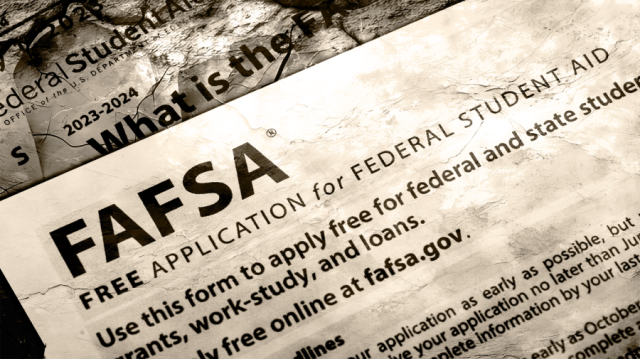
Updated February 19 – The customary deadline for high school seniors to finalize their college commitments has historically fallen on May 1.
However, due to delays from the federal government in introducing a new financial aid form, several institutions are opting to extend their registration deadlines. Joining this trend, the University of Wisconsin-Madison announced on Monday that it is pushing back its deadlines for admitted student deposits and on-campus housing contracts to May 15.
This decision will impact tens of thousands of students who have been accepted to the state’s flagship university, many of whom rely on aid offers to assess the financial implications of attending.
Overview of FAFSA Rollout Issues
In response to challenges faced during the rollout of the new Free Application for Federal Student Aid (FAFSA) for the 2024-25 school year, the Department of Education has announced measures to accelerate the financial aid award process.
The simplified version of the FAFSA aims to make the application process for student loans and grants more accessible. However, delays in availability and complications with transferring financial information to colleges have prompted criticism from lawmakers on both sides of the aisle.
Bipartisan Criticism and Urgent Calls for Action
Lawmakers, including a group of Republicans and over 100 Democratic representatives, have expressed concerns about the operational problems. The delay in financial aid processing is particularly alarming, as emphasized in a letter led by independent Sen. Bernie Sanders and Democratic Rep. Bobby Scott.
Want to know if you’re earning what you deserve? Find out with LawCrossing’s salary surveys.
Department of Education’s Response
Acknowledging the challenges, the Department of Education outlined three key steps to streamline the financial aid process:
1. Reduction of FAFSA Filers Selected for Verification
The agency will decrease the number of FAFSA filers subjected to the verification process, aiming to expedite the confirmation of accurate information on the forms. This step addresses a typically time-consuming audit-like process that has impacted one-third of applicants in previous years.
2. Suspension of Routine Program Reviews
To save time, the department will temporarily suspend routine program reviews conducted to confirm a college’s eligibility for federal funds. While serious issues like suspected fraud will still be addressed, the move is expected to alleviate the burden on colleges.
3. Increased Flexibility in Recertifying Eligibility
Colleges will be granted more flexibility in recertifying eligibility for federal aid by temporarily waiving the 90-day application requirement before the expiration date. This measure is designed to provide institutions with crucial time to focus on delivering aid to students.
Additional Support for Colleges and Universities
Last week, the Department of Education announced its commitment to providing personnel, funding, resources, and technology to selected colleges and universities. This support aims to facilitate the swift distribution of financial aid packages to students.
Understanding the FAFSA and Noteworthy Changes
Evolution of the FAFSA
The FAFSA, a key determinant of eligibility for federal Pell grants and student loans, has undergone significant changes with the latest version released in 2023. These changes, approved by Congress in 2019 and 2020, aim to streamline the application process.
Streamlining the Application Process
The new FAFSA, in contrast to its lengthy predecessors, features as few as 18 questions, taking less than 10 minutes to complete. Some information is directly extracted from tax returns, eliminating the need for applicants to search for details in older tax documents.
Projected Impact on Eligibility
The Department of Education anticipates a positive impact on eligibility, with an estimated 610,000 more students qualifying for a Pell Grant annually. The Pell Grant, a crucial resource for students from low-income families, is provided by the federal government and does not require repayment.
Additionally, an estimated 1.5 million more students are expected to be eligible for the maximum Pell Grant amount, offering significant financial support for their college education. The Pell Grant amount, which changes each year, currently stands at up to $7,395 for the current school year.
Decades of Repayment: A Journey through Federal Student Loan Forgiveness
Marlon Fox, a chiropractor in North Charleston, South Carolina, had been wrestling with his federal student debt since 1988. With a balance of $119,500 looming over him, he couldn’t envision the end. Then, on a fateful day in August 2023, relief arrived unexpectedly in his inbox with an email titled: “Your student loans have been forgiven!”
A Long-Awaited Redemption
Fox, now 65, described the moment as surreal. “I couldn’t believe it,” he said. “I’d been battling this for so long. I’ve been on cloud nine ever since.”
The Struggle of Long-Term Borrowers
Fox’s story is not unique. Many borrowers find themselves in repayment for decades without seeing the promised relief. Despite the provision in the U.S. Department of Education’s income-driven repayment plans allowing for debt forgiveness after 20 or 25 years, obstacles persist.
Nadine Chabrier from the Center for Responsible Lending attributes this to a lack of transparency from loan servicers, who are disincentivized to inform borrowers about available relief options.
Servicers: Gatekeepers to Relief
The Education Department contracts with various companies like Mohela, Nelnet, and EdFinancial to service federal student loans. Critics argue that these servicers, incentivized by fees per borrower per month, often fail to adequately inform borrowers about forgiveness opportunities and may mishandle payment records, especially during loan transfers between companies.
Scott Buchanan of the Student Loan Servicing Alliance refutes claims of intentional negligence, emphasizing their adherence to government standards.
The Impact of Review: A Glimmer of Hope
Despite the challenges, the Education Department’s review of borrowers in income-driven repayment plans has resulted in the forgiveness of approximately 930,000 loans, totaling over $45 billion in aid. Some borrowers, like Fox, even received reimbursements for overpayments.
The Weight of Decades: Fox’s Journey
Fox’s $60,000 student debt from attending the Palmer College of Chiropractic in the 1980s ballooned over the years due to forbearances and high interest rates. Despite enrolling in income-driven repayment plans, the balance decreased at a sluggish pace, impacting Fox’s financial stability and retirement plans.
The Long Road to Relief
Throughout his career and family obligations, Fox maintained frugality and perseverance, but the burden of student debt lingered, affecting his quality of life and retirement prospects.
A New Chapter: Hope on the Horizon
The Biden administration’s intervention brought Fox the relief he had long awaited. With his debt forgiven and a reimbursement of $56,801, Fox, for the first time in years, sees a glimmer of financial freedom.
Looking Ahead: A Journey to Redemption
While the weight of decades of repayment still casts a shadow over Fox’s life, he looks forward to a well-deserved vacation and newfound opportunities. Though the road was long and arduous, Fox’s story serves as a beacon of hope for countless others navigating the complexities of student loan repayment.
Don’t be a silent ninja! Let us know your thoughts in the comment section below.












































